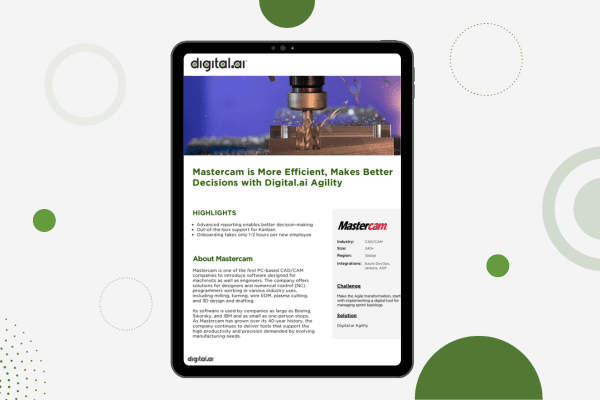Scaled Agile Framework (SAFe®) Principles
Understand SAFe® principles and master the key principles of successful implementation. Empower your organization for agility at scale.
Table of Contents
What is Scaled Agile Framework?
The Scaled Agile Framework (SAFe®) is a set of organizational and workflow patterns intended to guide enterprises in scaling lean and agile practices. It offers a structured approach to scaling agile across the organization, fostering alignment, collaboration, and rapid delivery of value to customers. Unlike Scrum that works well within small organizations or independent teams, SAFe is tailored for larger enterprises where interconnected teams collaborate on enterprise-scale projects.
Core Values of Scaled Agile Framework
SAFe® is underpinned by four core values that serve as guiding principles for organizations embracing agility at scale:
Alignment
Ensuring that all teams and stakeholders are aligned to a common mission and vision, fostering coherence and synergy across the enterprise. By aligning efforts and objectives, organizations can maximize efficiency, minimize duplication of efforts, and accelerate progress towards shared goals.
Built-In Quality
Emphasizing the importance of quality at every stage of the development process, thereby reducing defects and enhancing customer satisfaction. By prioritizing quality assurance and testing throughout the development lifecycle, organizations can deliver products and services that meet or exceed customer expectations.
Transparency
Promoting openness and visibility in all aspects of work, facilitating informed decision-making and collaboration among teams. By providing access to relevant information, metrics, and progress updates, organizations can enhance trust, alignment, and accountability across the enterprise.
Program Execution
Encouraging efficient and predictable delivery through iterative development, continuous integration, and regular cadence. By establishing disciplined Agile practices at the program level, organizations can minimize delays, mitigate risks, and deliver value to customers incrementally, ensuring responsiveness to changing market needs.
Key Components of Scaled Agile Framework
SAFe® comprises several key components that collectively enable organizations to scale agile practices effectively:
Agile Teams
Cross-functional teams that collaborate closely to deliver value incrementally, embracing agile principles such as self-organization and continuous improvement.
Agile Release Train
A long-lived team of agile teams that delivers value in a structured, predictable cadence, aligning with the organization’s objectives and milestones.
Portfolio Level
Strategic themes, budgets, and value streams managed at the portfolio level to optimize investment decisions and ensure alignment with business goals.
Value Streams
End-to-end workflows that deliver value to the customer, encompassing all activities from ideation to delivery and support.
The SAFe Implementation Roadmap
Implementing SAFe® requires a systematic approach that aligns with the organization’s goals and culture. The SAFe Implementation Roadmap provides a step-by-step guide for organizations to adopt and tailor SAFe® to their unique context, comprising the following stages:
- Prepare: Establishing the guiding coalition, defining the implementation strategy, and preparing the organization for change.
- Implement: Training teams, launching Agile Release Trains (ARTs), and executing the implementation plan according to the SAFe® principles and practices.
- Extend: Scaling agile practices beyond the initial implementation, fostering continuous improvement and innovation across the organization.
While understanding the foundational principles of SAFe® is crucial, successful implementation requires a strategic approach tailored to your organization’s unique needs and challenges. Here are fundamental principles to guide you on your journey:
- Leadership Commitment and Alignment: Effective implementation of SAFe® begins with strong leadership commitment and alignment. Leaders must champion adopting Lean-Agile practices, communicate the benefits to all stakeholders, and actively participate in the transformation process.
- Establish Clear Goals and Metrics: Define clear goals, metrics, and success criteria to guide your SAFe® implementation journey. Whether improving time-to-market, increasing customer satisfaction, or enhancing product quality, establishing measurable objectives ensures alignment and accountability.
- Fund Training and Education: Training and education are crucial to help your team thrive in a SAFe® environment. Individuals can participate in various training programs, workshops, and certification courses to improve and upgrade their skills in Agile practices, Lean principles, and SAFe® frameworks.
- Create Agile Release Trains (ARTs): Agile Release Trains (ARTs) serve as the backbone of SAFe®, enabling teams to plan, execute, and deliver value in a coordinated manner. Establishing ARTs aligns cross-functional teams around a common mission, facilitates collaboration, and accelerates time-to-market.
- Implement Lean Portfolio Management: Leverage Lean Portfolio Management principles to prioritize investments, allocate resources, and optimize the flow of value. Establishing governance mechanisms, decision-making frameworks, and feedback loops ensures portfolio decisions align with strategic objectives.
- Cultivate Communities of Practice: Foster communities of practice to facilitate knowledge sharing, collaboration, and continuous improvement. Organizations can foster a culture of excellence, drive innovation, and accelerate learning by bringing together like-minded individuals with shared expertise and interests.
- Embrace Continuous Improvement: Embrace a culture of continuous improvement to adapt and evolve in response to changing market dynamics. Encourage teams to examine their processes to identify areas for optimization and experiment with new practices to drive incremental enhancements.
Major Benefits of Implementing
The adoption of SAFe® offers a many of benefits to organizations in taking a standardized, system approach to scaling agile:
- Enhanced Alignment: Aligning business strategy with execution, fostering a shared understanding of organizational goals and priorities.
- Improved Time-to-Market: Accelerating delivery cycles, reducing lead times, and enabling faster response to customer needs and market changes.
- Increased Productivity: Empowering teams to collaborate more effectively, eliminate bottlenecks, and focus on high-priority tasks that drive value.
- Enhanced Quality: Embedding quality practices into every aspect of the development process, resulting in fewer defects and higher customer satisfaction
Challenges in Implementing Scaled Agile Framework
While the benefits of SAFe® are compelling, organizations have encountered various challenges during the implementation process as reporting in the latest State of Agile Report, including:
- Cultural Resistance: Overcoming resistance to change and ingrained siloed behaviors within the organization.
- Complexity: Managing the complexity inherent in large-scale agile transformations, including coordination among multiple teams and stakeholders.
- Skill Shortages: Addressing skill gaps and providing adequate training and support for teams transitioning to agile ways of working.
- Tooling and Infrastructure: Ensuring that the necessary tools, infrastructure, and technology are in place to support agile practices effectively.
SAFe Roles and Responsibilities
SAFe® defines several roles and responsibilities at different levels of the organization to facilitate effective implementation and execution:
Overview of SAFe Roles
- Release Train Engineer (RTE): Facilitates Agile Release Train processes and execution, ensuring alignment and coordination among teams.
- Product Owner (PO): Represents the voice of the customer, prioritizes features, and maintains the product backlog to maximize value delivery.
- Scrum Master: Facilitates Scrum events, coaches the team on agile principles and practices, and removes impediments to progress.
SAFe Team Level Roles
- Team Member: Cross-functional team members responsible for delivering value incrementally, collaborating closely to achieve sprint goals.
- Product Manager: Collaborates with the Product Owner to define the product vision, strategy, and roadmap, ensuring alignment with business objectives.
SAFe Program Level Roles
- Program Manager: Oversees the execution of Agile Release Trains (ARTs), manages risks and dependencies, and facilitates communication across teams.
- Solution Architect: Provides architectural guidance and technical leadership to ensure the scalability, reliability, and security of the solution.
By embracing the core values, components, and practices of SAFe®, enterprises can empower themselves for agility at scale, driving innovation, efficiency, and customer satisfaction. However, navigating the implementation challenges and defining clear roles and responsibilities are crucial steps in realizing the full potential of SAFe® within the organization.
Empowering Your Organization for Agility at Scale
Achieving agility at scale is a journey that requires dedication, perseverance, and a relentless focus on continuous improvement. By embracing SAFe® principles and mastering the key pillars of successful implementation, you can empower your organization to thrive in today’s competitive landscape.
Here are actionable steps to empower your organization for agility at scale:
- Lead by Example: Demonstrate leadership commitment to Lean-Agile principles and practices, and lead by example in embodying the values of collaboration, transparency, and adaptability.
- Foster a Culture of Learning: Encourage teams to challenge the status quo and relentlessly pursue excellence by creating a continuous learning, experimentation, and innovation culture.
- Empower Autonomous Teams: Empower cross-functional teams to make autonomous decisions, take ownership of their work, and drive outcomes that align with organizational goals.
- Leverage Technology and Tools: Invest in technology and tools that support Agile practices, streamline workflows, and enhance collaboration across distributed teams.
- Measure Progress and Adapt: Establish metrics, feedback loops, and governance mechanisms to measure progress, identify bottlenecks, and adapt your approach based on empirical data and insights.
- Celebrate Success and Learn from Failure: Celebrate successes, recognize achievements, and learn from failures to foster a culture of resilience, agility, and continuous improvement.
- Stay Agile and Evolve: It’s important to remain flexible and adaptable to market shifts, customer requirements, and technological advancements. Rather than fearing change, embrace it as a catalyst for growth and innovation. Continuously refine your processes, strategies, and practices.
Mastering SAFe principles and implementing Agile practices on a large scale is crucial for organizations aiming to excel in the current dynamic and competitive landscape. Embracing Lean-Agile principles, enhancing collaboration, empowering teams are key strategies to realizing your organization’s full potential, leading to sustainable growth and innovation.
Agile is not something that has an end date. It is a continuous process of learning, adapting, and improving. It’s crucial to remain committed to your Agile transformation, make use of the benefits of SAFe, and enable your organization to pursue a path of excellence and success.





